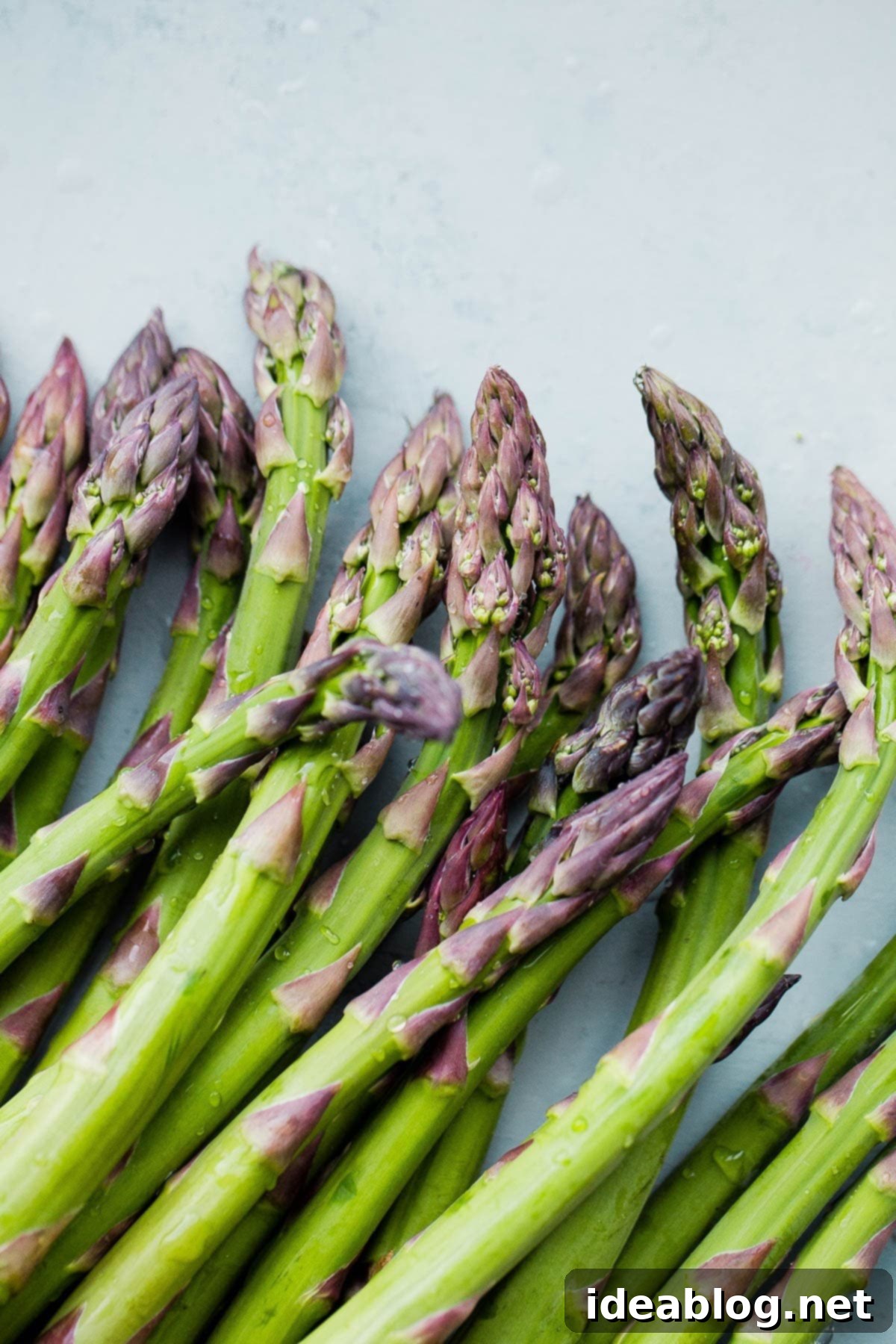The Ultimate Guide to Asparagus: Selection, Storage, Cooking & Delicious Recipes
Shopping Tips | How to Store | Varieties | Cooking Tips | Recipes & Pairings
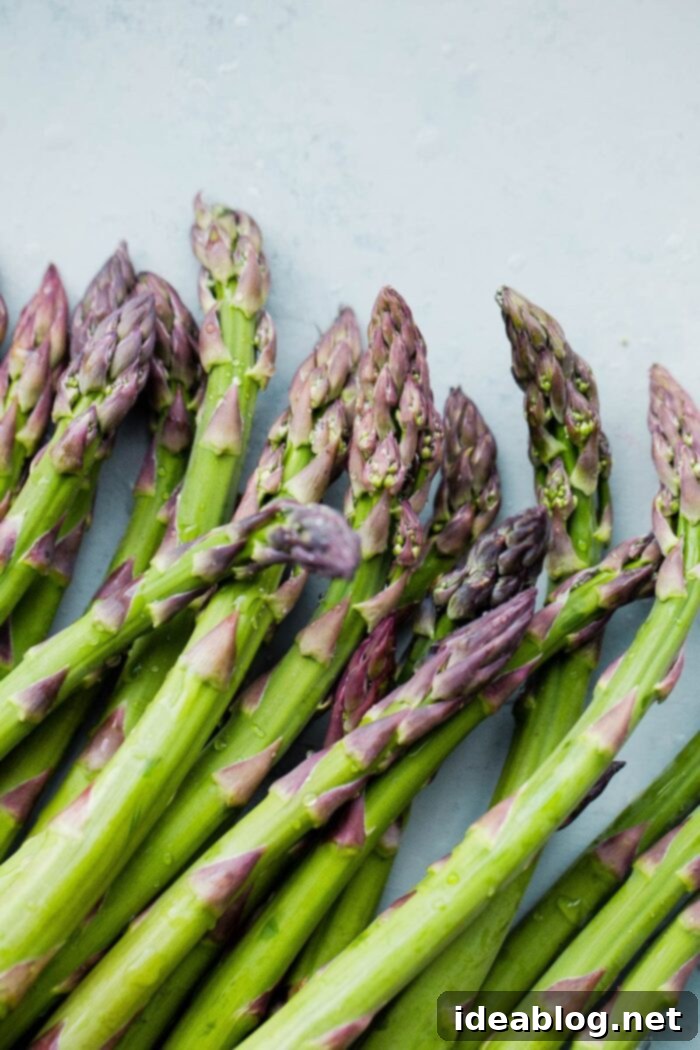
Spring has officially arrived, and with it, the much-anticipated asparagus season! This vibrant green stalk, a true herald of warmer weather, brings a unique freshness and delicate flavor to countless dishes. In this comprehensive guide, we’re diving deep into everything you need to know about asparagus: from expert tips on how to pick the best bunches and effective methods for how to store asparagus to exploring its fascinating varieties, mastering diverse cooking techniques, and inspiring you with delicious recipe ideas.
There’s an undeniable magic to local, freshly picked asparagus. Its crisp texture and sweet, earthy flavor are simply unparalleled. Once you’ve experienced the difference, you’ll understand why sourcing quality asparagus is so crucial. Let’s unlock the secrets to enjoying this incredible spring vegetable at its absolute best!
How to Pick Good Asparagus: Expert Shopping Tips
Timing is everything when it comes to asparagus. Its prime season generally spans from March to early June, although this can vary slightly by region. This narrow window is when you’re most likely to discover local or regionally sourced asparagus, which consistently offers the highest quality and freshest flavor. Given its short-lived season, it’s wise to take full advantage of it while it lasts!
Understanding Freshness and Flavor
Like many delicate vegetables, asparagus begins to lose moisture, flavor, vital antioxidants, and phytonutrients remarkably quickly once it’s harvested. The stalks are at their peak natural sugar content – and therefore, their best flavor – immediately after being picked. This inherent perishability underscores why it’s so important to purchase and consume asparagus during its natural season, prioritize local sourcing whenever possible, and aim to prepare it the very same day or the day after purchase for optimal taste and nutritional value.
What to Look For at the Market
When selecting a bunch of asparagus, keep these visual cues in mind:
- Firm, Straight Stalks: Choose stalks that feel rigid and stand upright. Flabby or limp asparagus is a clear sign of age and moisture loss.
- Tightly Closed Spears: The tips, or spears, should be compact and firm, not fanned out, mushy, or flowering. Opened tips indicate the asparagus is past its prime.
- Smooth, Colorful Ends: Inspect the cut ends of the stalks. They should appear fresh, moist, and consistent in color with the rest of the stalk. Avoid ends that are dry, brittle, woody, or discolored white, as these suggest the asparagus has been stored for too long or is dehydrated.
- Avoid Imperfections: Steer clear of any bunches with mushy, bruised, or wilted spears. These are indicators of damage or spoilage.
- Water-Bathed Bunches: If you see asparagus displayed with its ends sitting in shallow pools of water, check these first. This method helps maintain hydration and often means the asparagus is in better condition.
Stalk Thickness: A Common Misconception
Many believe that thinner asparagus stalks are more tender or of higher quality than thicker ones, or vice-versa. However, stalk thickness is not an indication of quality or maturity; instead, it’s primarily related to the age and sex of the asparagus plant. Both thin and thick stalks can be incredibly tender and delicious when fresh. The main difference lies in how you might choose to cook them, which we’ll explore in the cooking tips section below.
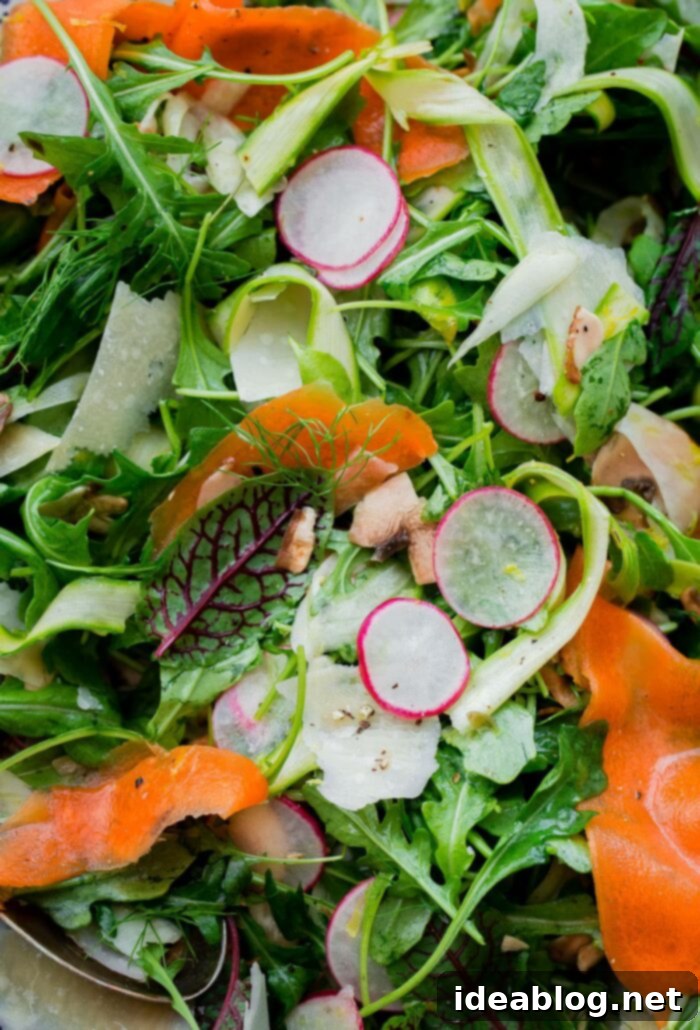

How to Store Asparagus to Maximize Freshness
Proper storage is paramount for extending the life and preserving the quality of your freshly purchased asparagus. Without the right approach, asparagus can quickly become limp, dry, and lose its vibrant flavor. The goal is to keep the stalks hydrated and cool, mimicking the conditions in which they thrive. Here are the most effective methods for how to store asparagus:
Method 1: The Damp Linen & Bag Method
- Prepare the Stalks: Upon bringing your asparagus home, remove any rubber bands that bind the bunch. This allows the stalks to breathe and prevents moisture accumulation in tight spots.
- Hydrate the Ends: Take a clean kitchen linen or a few paper towels and dampen them slightly. Wrap these around the cut ends of the asparagus stalks. This provides a constant, gentle source of moisture to the parts of the plant that would naturally draw water.
- Containerize: Place the wrapped asparagus bundle into a perforated plastic bag or a loosely sealed Ziploc bag. The bag helps to create a humid environment around the stalks, further preventing moisture loss, while perforations allow for some air circulation to prevent mold.
- Refrigerate: Store the bagged asparagus in the produce drawer of your refrigerator. The crisper drawer is specifically designed to maintain optimal humidity levels for vegetables.
Method 2: The “Flower Arrangement” Method
This method is highly recommended as it keeps the asparagus exceptionally fresh and hydrated:
- Trim if Necessary: If the very ends of your asparagus stalks appear dry or woody, trim about a half-inch off the bottom before storing. This exposes fresh tissue that can more readily absorb water.
- Water Bath: Stand the asparagus stalks upright, spears facing up, in a wide-mouthed jar, glass, or container. Fill the jar with about 1 inch of fresh water, much like you would arrange a bouquet of flowers. The asparagus will draw water up through its stems, keeping the entire stalk hydrated.
- Cover (Optional but Recommended): For even better preservation, you can loosely cover the top of the asparagus spears with a plastic bag or plastic wrap. This helps to maintain humidity around the tips and prevents them from drying out.
- Refrigerate: Place the jarred asparagus in your refrigerator. Change the water every day or two to keep it fresh.
When to Use and How to Prepare Before Cooking
Asparagus is best used within a day or two of purchasing, especially if you want to experience its peak flavor and tenderness. Do not rinse or wash the stalks until just before you are ready to use them. Excess moisture sitting on the stalks can encourage spoilage. Before cooking, gently bend each spear until it naturally snaps – this usually indicates where the tough, woody end separates from the tender stalk. Discard these fibrous ends, or if you prefer, use a sharp knife to trim them. For very thick or slightly fibrous stalks, a vegetable peeler can be used to peel the bottom few inches for a more tender bite.
The Science of Asparagus Freshness
As touched upon earlier, once picked, asparagus begins to rapidly lose its natural sugars and vital nutrients. Over time, the ends of the stalks, in particular, become increasingly tough and fibrous. This degradation not only affects the texture and flavor but also results in more waste when trimming, effectively increasing your cost per pound. Wrinkled or overly tough stalks are reliable indicators that the asparagus was likely harvested some time ago and is not at its freshest. For the most superior eating experience, always prioritize locally grown and in-season asparagus. While it might come at a slightly higher cost, the unparalleled quality, freshness, and flavor make it a worthwhile investment.
Freezing Asparagus for Extended Storage
If you find yourself with an abundance of fresh asparagus during peak season and want to enjoy it year-round, freezing is an excellent option. However, it’s crucial to blanch asparagus before freezing to preserve its color, flavor, and texture. To do this, trim and cut the asparagus into desired lengths. Blanch in boiling salted water for 2-4 minutes (thinner spears require less time). Immediately transfer to an ice bath to stop the cooking process, then drain thoroughly, pat dry, and freeze in a single layer on a baking sheet before transferring to airtight freezer bags.
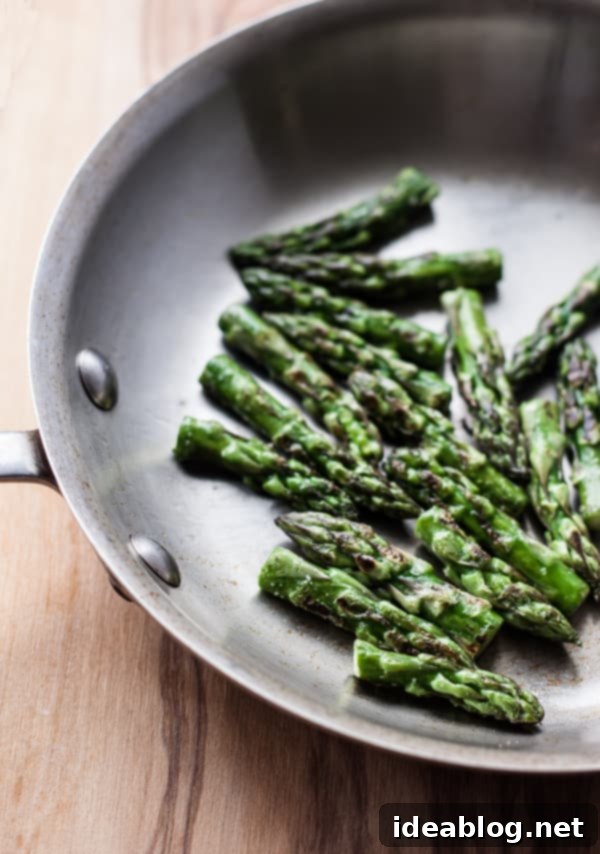
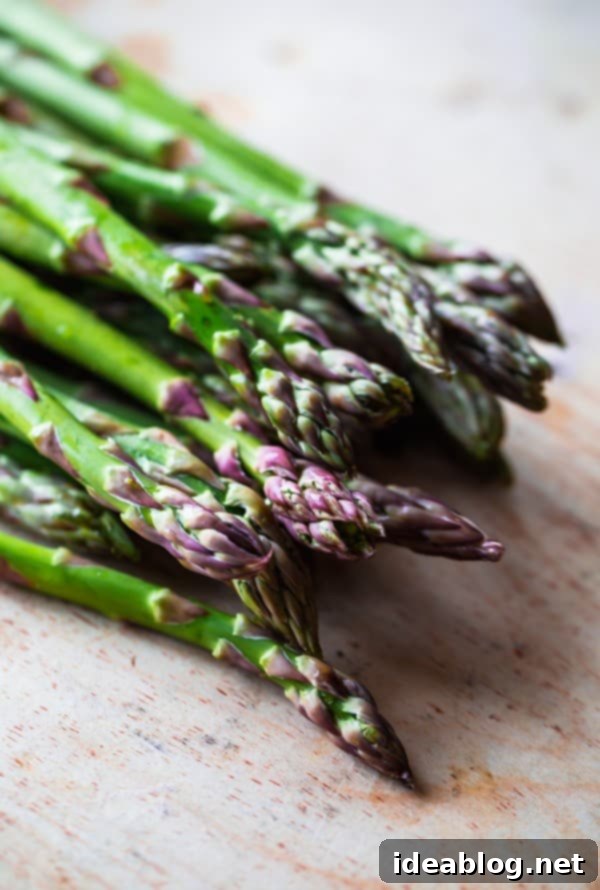
Types of Asparagus: Exploring Varieties Beyond Green
While green asparagus is the most familiar sight in grocery stores, the world of asparagus offers a surprising diversity of varieties, each with its own unique characteristics. These different types can vary in color, flavor, and ideal culinary applications, making them a delight for adventurous cooks. Though some might be challenging to find outside of local farmer’s markets or specialty stores, knowing about them can enrich your appreciation for this wonderful vegetable.
1. Green Asparagus
This is by far the most commonly available type of asparagus, and what most people envision when they think of this spring vegetable. However, even within “green asparagus,” there are numerous sub-varieties. Its flavor is typically robust, earthy, and slightly bitter, becoming sweeter when cooked. When seeking out the best green asparagus, keep an eye out for those with dark purple-hued spears (as shown in the photo below). These are often an indicator of local growth and exceptional freshness, offering an absolutely fantastic taste experience that surpasses standard green varieties.
2. Purple Asparagus
Visually striking and delightfully flavorful, purple asparagus stands out with its vibrant amethyst color. This variety is known for being milder and sweeter in flavor than its green counterpart, often described as having nutty or even fruity undertones. A significant advantage of purple asparagus is its nutritional profile; it contains three times the antioxidants (anthocyanins, which give it its color) as most green varieties. However, there’s a trick to preserving its beautiful hue: the purple color tends to fade when exposed to excessive heat or water during cooking. To maintain its vibrant appearance and delicate flavor, opt for raw preparations like salads, quick grilling, or a light sear.
3. White Asparagus
White asparagus is a culinary treasure, especially revered in European and French cuisine. Interestingly, it’s not a separate species or variety from green asparagus; rather, its pallid color is a result of its unique cultivation method. White asparagus is grown completely underground, or covered with mounds of soil (a process called “blanching” in horticulture) as it grows. This prevents any exposure to sunlight, which is necessary for chlorophyll production – the pigment that gives plants their green color. Without chlorophyll, the stalks remain white. In terms of flavor, white asparagus is notably milder and more delicate than green asparagus, often described as having a slightly nutty, less bitter taste. While it’s considered a delicacy, it is typically lower in nutrients compared to its green and purple cousins due to the lack of sunlight exposure.
Other Less Common Varieties
Beyond these main types, there are also rarer varieties such as “Wild Asparagus,” which is typically much thinner and has an even more intense, concentrated flavor, often foraged in specific regions. Exploring these different types offers a fascinating journey through the culinary possibilities of asparagus.
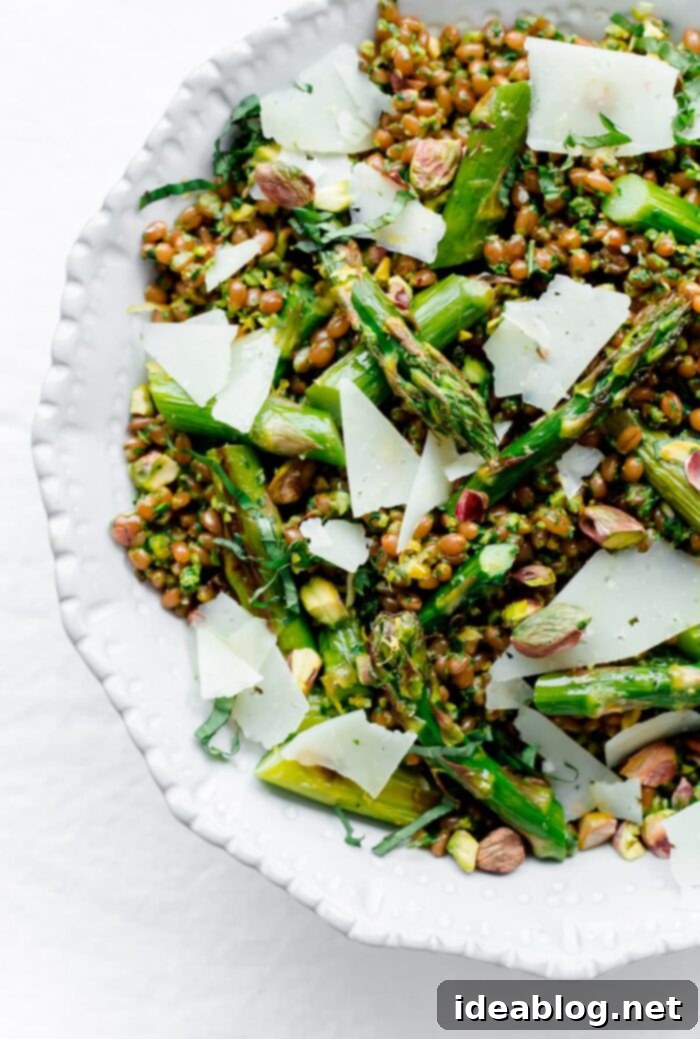
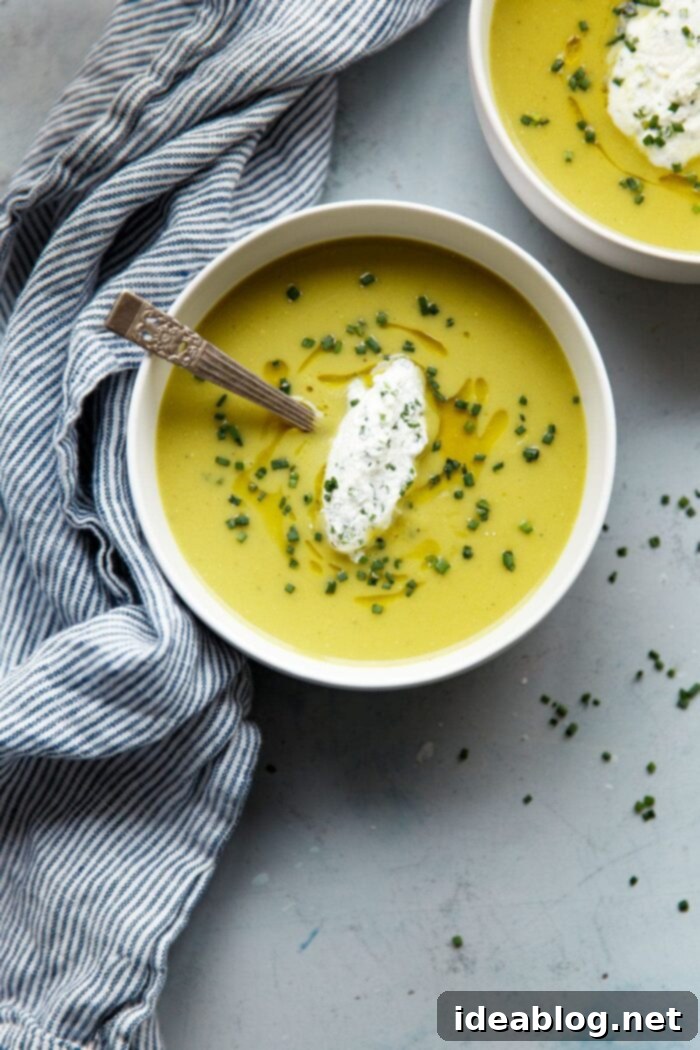
How to Cook Asparagus: Mastering Various Techniques
Asparagus is incredibly versatile and can be prepared using a multitude of cooking methods, each bringing out different aspects of its flavor and texture. While steamed asparagus actually retains a higher concentration of antioxidants compared to raw, my absolute favorite ways to prepare this delightful vegetable are roasting and grilling. These methods impart a beautiful caramelization and depth of flavor that’s hard to beat.
Roasting Asparagus
Roasting is perhaps the easiest and most consistently delicious way to cook asparagus. Simply toss the trimmed asparagus stalks with a good quality olive oil, a generous pinch of salt, and freshly ground black pepper. For extra flavor, you can add minced garlic, lemon zest, or a sprinkle of your favorite herbs like thyme or rosemary. Spread the asparagus in a single layer on a baking sheet and roast in a hot oven (400°-425°F / 200°-220°C) for 10-20 minutes, depending on thickness, until fork-tender and slightly browned at the tips. This method creates a tender-crisp texture with a slightly nutty, sweet flavor.
Grilling Asparagus
Grilling imbues asparagus with a fantastic smoky char and tender interior. It’s especially well-suited for medium to thick stalks, which are less likely to fall through the grates. Lightly coat the trimmed spears with olive oil, salt, and pepper. Grill over medium-high heat for 5-10 minutes, turning occasionally, until they have attractive grill marks and are tender. A squeeze of lemon juice after grilling enhances its fresh flavor.
Sautéing Asparagus
Sautéing is ideal for thinner, more delicate asparagus stalks. If your stalks are thin, chop or slice them on a bias into 1 to 2-inch pieces. Heat a tablespoon of olive oil or butter in a wok or large skillet over medium-high heat. Add the asparagus pieces and sauté for 3-7 minutes, stirring frequently, until they are vibrant green and fork-tender. This method is quick and perfect for incorporating asparagus into stir-fries or alongside other quick-cooking ingredients.
Steaming or Blanching Asparagus
For a crisp-tender texture and to preserve the brightest green color, steaming or blanching are excellent choices. Steaming takes about 3-6 minutes for most stalks, resulting in a gentle, pure asparagus flavor. Blanching involves a quick dip (1-3 minutes) in boiling salted water, followed immediately by an ice bath to stop the cooking process and lock in that vibrant hue. This technique is particularly useful for dishes where you want to maintain the asparagus’s vivid color, such as in this Asparagus and Goat Cheese Quiche or various salads.
Cooking Different Stalk Thicknesses
- Thin Asparagus: Best for quick cooking methods like sautéing, stir-fries, or gentle steaming. They also excel when shaved raw into ribbons for salads like this Shaved Vegetable Salad, offering a delicate crunch.
- Medium Asparagus: Highly versatile, suitable for roasting, grilling, steaming, or blanching. This is your go-to for most recipes.
- Thick Asparagus: These benefit from longer cooking times and robust methods. Grilling is fantastic as they won’t fall through grates. They’re also excellent for steaming or blanching, or can be chopped and used in hearty dishes like Asparagus Soup. If slightly fibrous, peeling the bottom ends can greatly improve their texture.
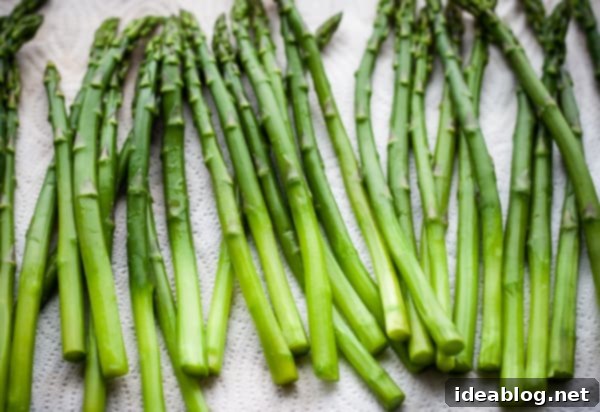
Quick Cook Tip: For an effortless way to incorporate fresh spring vegetables into your pasta dishes, simply drop chopped asparagus into the salted boiling water during the last 2-3 minutes of the pasta’s cooking time. They’ll cook perfectly alongside the pasta, saving you time and extra dishes.

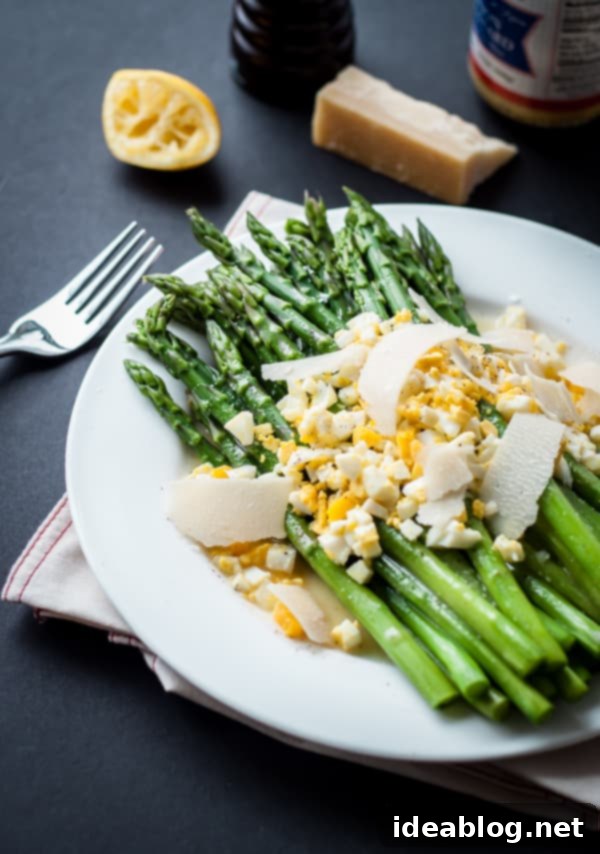
Flavor Pairings and Delicious Asparagus Recipes
Asparagus, with its relatively delicate yet distinctive flavor, serves as a fantastic canvas for a wide array of ingredients. Its earthy notes complement both rich and bright flavors, making it incredibly versatile in the kitchen. Understanding its natural affinities can elevate your asparagus dishes from good to extraordinary.
Top Flavor Pairings for Asparagus:
- Eggs: A classic combination! The richness of eggs, whether fried, poached, scrambled, or in an omelet, perfectly balances the freshness of asparagus. Think asparagus and poached eggs for breakfast or a frittata for brunch.
- Cheese (especially Parmigiano-Reggiano): Salty, umami-rich hard cheeses like Parmigiano-Reggiano, Pecorino Romano, or even a creamy goat cheese, enhance asparagus’s natural sweetness. A simple sprinkle of grated Parmesan over roasted asparagus is divine.
- Lemon and Other Citrus: The bright, acidic notes of lemon juice or zest cut through the earthiness of asparagus, making it taste even fresher and more vibrant. A squeeze of lemon is almost always a good idea when serving asparagus.
- Garlic: A universally loved aromatic, garlic adds a pungent warmth that complements asparagus beautifully, whether minced and sautéed or roasted whole alongside the spears.
- Tarragon: This herb, with its distinct anise-like flavor, is a classic pairing with asparagus, particularly in French cuisine. It adds an elegant, sophisticated touch.
- Mushrooms: Earthy mushrooms, like cremini or shiitake, echo the savory notes of asparagus and create a wonderfully synergistic flavor profile in risottos or sautés.
- Balsamic Vinegar: A drizzle of good quality balsamic vinegar, especially a reduced glaze, adds a sweet-tart depth that can bring out the best in roasted or grilled asparagus.
- Nuts: Toasted almonds, pine nuts, or pistachios add a delightful crunch and nutty flavor that complements the tender spears.
- Prosciutto/Bacon: The salty, crispy nature of cured meats like prosciutto or bacon provides a savory counterpoint to the fresh vegetable, often seen wrapped around spears or crumbled over them.
Ready to get cooking? Here are a few of my favorite asparagus recipes that beautifully showcase these pairings and cooking techniques:
- Roasted Asparagus Wheat Berry Salad with Arugula Pistachio Pesto: A hearty and flavorful salad that combines tender roasted asparagus with wholesome wheat berries and a vibrant pesto.
- Asparagus Potato Soup with Chive Cream: A comforting and creamy soup, perfect for cool spring evenings, featuring the delicate taste of asparagus and a hint of fresh chives.
- Asparagus Egg Puff Pastry Tart: An elegant and easy-to-make tart, ideal for brunch or a light lunch, combining fluffy eggs, savory prosciutto, and fresh asparagus on a crispy puff pastry base.
- Spring Asparagus and Goat Cheese Quiche: A classic quiche featuring the tangy creaminess of goat cheese and the freshness of spring asparagus, encased in a flaky crust.
- Classic Asparagus Mimosa Salad: A timeless French-inspired salad where blanched asparagus is adorned with finely chopped hard-boiled eggs (mimosa style) and a light vinaigrette.
Health Benefits of Asparagus
Beyond its delightful taste, asparagus is also a nutritional powerhouse, offering a wealth of health benefits. It’s an excellent source of essential vitamins and minerals, including:
- Vitamin K: Crucial for blood clotting and bone health.
- Folate (Vitamin B9): Important for cell growth and DNA formation, especially vital during pregnancy.
- Vitamin A: Contributes to vision, immune function, and skin health.
- Vitamin C: A powerful antioxidant that supports the immune system.
- Fiber: Promotes digestive health, helps regulate blood sugar, and contributes to a feeling of fullness.
- Antioxidants: Contains various antioxidants, including flavonoids and polyphenols, which help protect cells from damage by free radicals, potentially reducing the risk of chronic diseases.
- Asparagine: An amino acid that gives asparagus its distinct flavor and acts as a natural diuretic.
Incorporating asparagus into your diet is a delicious way to boost your nutrient intake and support overall well-being. Enjoy it fresh, cooked, or as part of a vibrant spring meal!
Resources: Further Reading and Culinary Inspiration
For those eager to deepen their culinary knowledge and understanding of food, these resources provide invaluable insights into ingredients, flavor science, and healthy eating:
- Eating on the Wild Side: The Missing Link to Optimum Health by Jo Robinson: An enlightening book on how to select, store, and cook common fruits and vegetables to maximize their nutritional value.
- The Flavor Bible + The Vegetarian Flavor Bible by Karen Page and Andrew Domenburg: Essential guides for cooks, these books offer an encyclopedic listing of ingredients and their complementary flavors, helping you create harmonious and delicious dishes.
- On Food and Cooking: The Science and Lore of the Kitchen by Harold McGee: A seminal work that delves into the chemistry and physics of food and cooking, explaining how ingredients work and why certain techniques yield specific results.
- The Chef’s Garden by Farmer Lee Jones and Kristin Donnelly: Explores the philosophy and practices behind growing exceptional vegetables, offering a deeper connection to where our food comes from and how it can be best appreciated.
